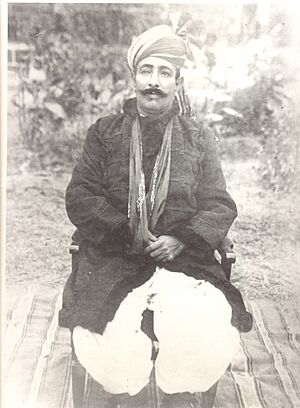Amb (princely state) facts for kids
Amb was a special area in what used to be the British Raj, which is now Pakistan. It was like a small country that ruled itself. This means it had its own government and laws. However, it was still under the general authority of the British monarch.
Amb was led by a prince called a Nawab. This title was passed down through the family. The Nawab of Amb was also the main leader of the Tanoli tribe. This tribe is part of the Pashtun group from the Ghilji confederation in the Hazara region.
In 1947, when India was divided, the Nawab of Amb decided to join the new country of Pakistan. Amb remained a separate state within Pakistan until 1969. Then, it became part of the Khyber Pakhtunkhwa province. The special royal status of the Nawab was ended by the Government of Pakistan in 1972.
The area where Amb was located is known as Tanawal. This region is in Hazara, which is now part of Khyber Pakhtunkhwa. The part that Amb covered is called "Upper Tanawal". It is now in Mansehra District. "Lower Tanawal" is in the Abbottabad District. The name "Tanawal" comes from the Tanoli tribe who live there. The Tanoli people are Muslims and they speak Hindko.
A Look at Amb's Past
Amb and the land around it have a very old history. It goes back to the time when Alexander the Great came to this region. There was a place called Embolina near the Indus River. Ancient writers like Arrian and Ptolemy wrote about it. The Nawabs of Amb later took their title from this old name.
Amb was once known as Mulk e Tanawal. This means "the country of Tanawal". The early history of this area goes back centuries before the Mughal Empire. In the early 1300s, the Tanoli tribe arrived here from Central Asia, after traveling through Afghanistan. They took control of the land and settled along the Indus River. A large area around the river became known as Tanawal.
For a long time, the Tanawal area stayed mostly free from the power of the Mughals and Sikhs. Later, they had only a little contact with the British. Because of this, the people of Tanawal did not interact much with other places. They often preferred to be ruled by their own local chiefs.
Until the late 1700s or early 1800s, Tanawal was not one single state. It was an area where several important Tanoli chiefs had power over different parts. The Hindwal section chiefs were stronger than the others. In 1772, Mir Haibat Khan became the chief of Upper Tanawal. Later, his family members became the Nawabs of Amb under the British Raj. They continued to rule this land until 1972.
Who Ruled Amb?
The rulers of Amb belonged to the Hindwal part of the Tanoli tribe. The Tanoli rulers are believed to be from Mughal family lines. They are thought to be descendants of a Barlas Turk named Ameer Khan Turk. However, very old records of the tribe are not available from before the 1700s.
List of Nawabs
The Nawabs, or rulers of Amb, were:
- Mir Haibat Khan
- Mir Navab Khan
- Mir Painda Khan (died 1843)
- Mir, later Nawab Jehandad Khan (1843–1868)
- Sir Nawab Muhammad Akram Khan (1868–1907)
- Sir Nawab Khan i Zaman Khan (1907–1936)
- Sir Nawab Muhammad Farid Khan (1936–1971)
- Nawab Muhammad Saeed Khan (1971–1972; held the title only, 1972–1973)
The idea of hereditary rulers was ended in Pakistan on January 1, 1972. This happened because of a change to the country's constitution. This meant that the Nawab of Amb was no longer officially recognized as a ruler. They could also no longer use their old titles.
The current head of the old royal family is Salahuddin Saeed Khan. He has held this position since 1973. He is the son of the last Nawab. He is allowed to use the special title of 'Nawabzada', which means 'son of a Nawab'.
Images for kids
-
From left to right: Sahibzada Mohammad Khurshid (first Pakistani Governor of Khyber-Pakhtunkhwa), Nawabzada Liaquat Ali Khan (first Prime Minister of Pakistan), Nawab Sir Muhammad Farid Khan Tanoli (Nawab of Amb) and Begum Ra'ana Liaquat Ali Khan (wife of Liaquat Ali Khan). Darband, Amb State, 1949.
See also
 In Spanish: Amb (estado principesco) para niños
In Spanish: Amb (estado principesco) para niños











